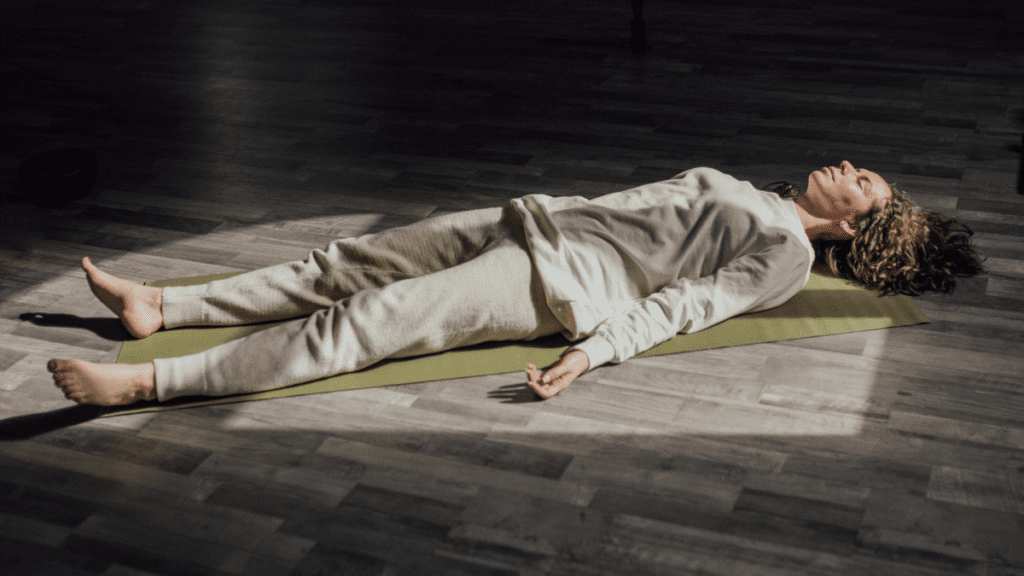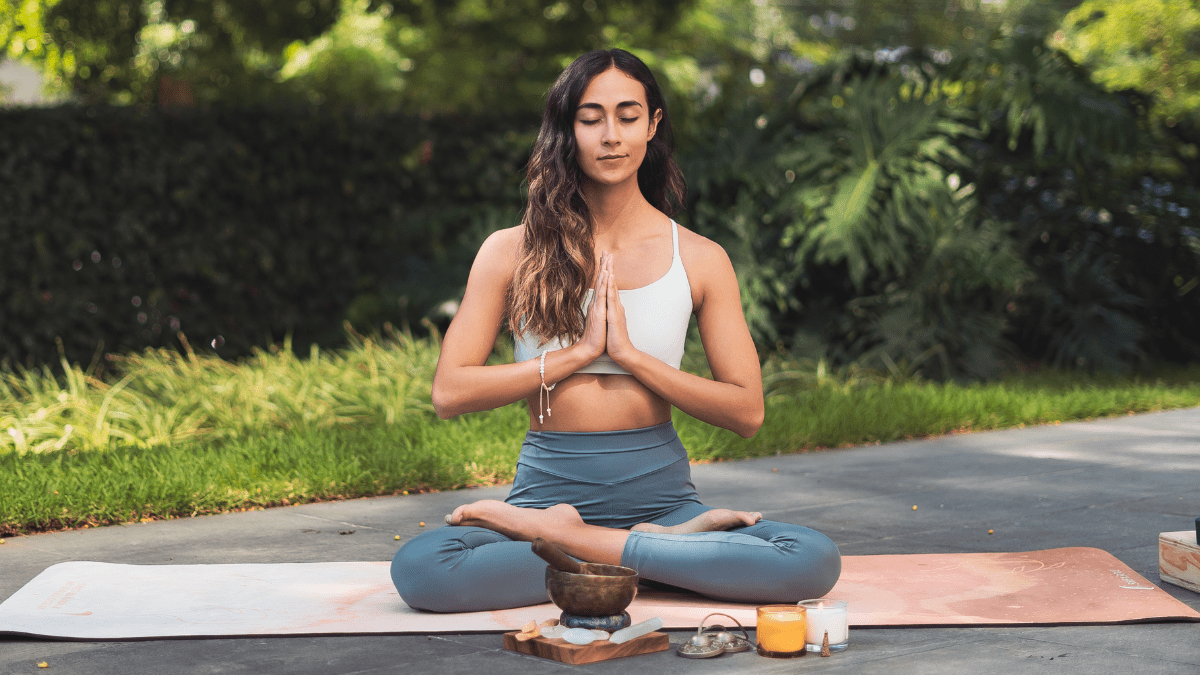Yoga Nidra for Deep Sleep: Unlock Peace in 15 Minutes
Yoga Nidra for deep sleep rewires your nervous system, silences racing thoughts, and invites soul-deep rest. Discover how 15 minutes can change your sleep—forever.

In This Article
- Why Yoga Nidra for Deep Sleep Is the Ultimate Rest Practice
- What Is Yoga Nidra and Why It Works for Deep Sleep
- The Science Behind Yoga Nidra for Deep Sleep
- How to Practice Yoga Nidra for Deep Sleep at Home
- Best Guided Yoga Nidra for Deep Sleep Resources
- Real Benefits of Yoga Nidra for Deep Sleep Over Time
- Yoga Nidra for Deep Sleep — Conclusion
- Yoga Nidra for Deep Sleep — FAQ
Why Yoga Nidra for Deep Sleep Is the Ultimate Rest Practice
Sleepless nights are more common than ever. Racing thoughts, body tension, and anxious energy often steal our rest before it even begins. But there’s a proven method to break the cycle. Yoga Nidra for deep sleep is not just a practice—it’s a powerful reset for your nervous system.
Unlike meditation, it guides you into conscious sleep. In just 15 minutes, your mind can shift into deep calm. Even better, this practice requires no flexibility, no special poses, and no experience.
In this article, you’ll discover how Yoga Nidra works, why it’s scientifically backed, and how to use it for better sleep tonight. If you’ve tried other methods without lasting relief, this may finally be the breakthrough. You may also want to explore how meditation can support better sleep in this post.
So, how does this ancient practice create such deep rest? Let’s dive in.
What Is Yoga Nidra and Why It Works for Deep Sleep
How Does Yoga Nidra Differ from Traditional Meditation?
Yoga Nidra and traditional meditation both aim to calm the mind, yet they differ significantly. In meditation, practitioners typically sit upright, focusing intently to achieve mindfulness. This active engagement requires effort and concentration. In contrast, Yoga Nidra invites you to lie down in a comfortable position, guiding you toward a state between wakefulness and sleep. This approach allows for deep relaxation without the need for sustained focus, making it accessible to many.
Why Is Yoga Nidra Effective for Insomnia and Anxiety?
Insomnia and anxiety often stem from an overactive nervous system. Yoga Nidra addresses this by activating the parasympathetic nervous system, which promotes relaxation and reduces stress. As you progress through the guided practice, your body transitions from tension to tranquility. This shift not only aids in falling asleep faster but also enhances sleep quality. Regular sessions can decrease anxiety levels, providing a natural remedy for restless nights.
Can Your Brain Truly Rest While Remaining Conscious?
During Yoga Nidra, the brain undergoes notable changes. Initially, as you begin to relax, alpha brain waves increase, associated with calm and alert states. As relaxation deepens, theta waves emerge, linked to creativity and subconscious insights. In the most profound stages, delta waves appear, indicative of deep, restorative sleep. Remarkably, throughout this process, a level of conscious awareness is maintained. This unique state allows the body to rest deeply while the mind remains alert, facilitating both physical rejuvenation and mental clarity.
The Science Behind Yoga Nidra for Deep Sleep
What Occurs in the Brain During Yoga Nidra?
Yoga Nidra guides you into a unique state of consciousness. As you relax, your brain transitions through various wave patterns. Initially, alpha waves dominate, indicating a relaxed yet alert mind. As the practice deepens, theta waves emerge, associated with creativity and deep relaxation. In the most profound stages, delta waves appear, which are linked to deep, restorative sleep. This progression allows the body to rest deeply while the mind remains aware, promoting both physical and mental rejuvenation.
Is Yoga Nidra as Restorative as Traditional Sleep?
Yoga Nidra offers rest that complements traditional sleep. While it doesn’t replace the need for regular sleep, it provides a unique form of rest. Practicing Yoga Nidra can lead to increased delta wave activity, which is associated with deep sleep and improved cognitive function. This suggests that Yoga Nidra can enhance the quality of rest and support overall well-being.
Can Yoga Nidra Serve as an Alternative to Naps or Sleep Aids?
Yoga Nidra presents a natural alternative to naps and sleep aids. By promoting relaxation and reducing stress, it can help alleviate sleep disturbances. Regular practice may lead to improved sleep patterns and reduced reliance on sleep medications. However, it’s essential to consult with a healthcare professional before making changes to prescribed treatments.

How to Practice Yoga Nidra for Deep Sleep at Home
What Essentials Do You Need to Begin Yoga Nidra for Deep Sleep?
Starting Yoga Nidra at home is straightforward. First, find a quiet, comfortable space where you won’t be disturbed. A yoga mat or a soft carpet works well. Lie down on your back, allowing your arms to rest naturally by your sides. To enhance comfort, consider using a pillow under your head and a bolster under your knees. Covering yourself with a light blanket can also help maintain warmth during the practice. Ensure the room is dimly lit or dark to promote relaxation.
When Is the Optimal Time to Practice Yoga Nidra for Deep Sleep?
The ideal time varies depending on individual schedules and needs. Practicing in the evening, shortly before bed, can prepare your body and mind for restful sleep. Alternatively, engaging in a session during the day can serve as a rejuvenating break, reducing stress and enhancing focus. Consistency is key; establishing a regular routine helps signal your body to relax at the designated time.
How Long Should a Yoga Nidra Session Be for Effective Deep Rest?
Session lengths can vary, typically ranging from 15 to 45 minutes. Beginners might start with shorter sessions to build familiarity with the practice. As comfort with the technique grows, longer sessions can be more beneficial, allowing for deeper relaxation and more profound restorative effects. Even brief sessions, however, can provide significant benefits when practiced regularly.
Best Guided Yoga Nidra for Deep Sleep Resources
Where Can You Find Quality Yoga Nidra for Deep Sleep Recordings?
When starting out, it’s important to find guided sessions that truly support deep rest. Fortunately, there are many platforms offering Yoga Nidra recordings specifically designed for sleep. Some focus more on body awareness, while others guide you through calming visualizations. As a result, you’ll want to explore a few until one resonates with you. Once you find a session that feels grounding and soothing, it’s best to return to it regularly. Over time, this routine will help signal your body and mind that it’s time to relax.
What Qualities Should You Look for in a Yoga Nidra Voice or Tone?
Choosing the right voice can make or break your experience. Ideally, the guide’s tone should be soft, even, and reassuring. In addition, a slower pace gives your mind time to follow each instruction with ease. While some recordings include gentle music or nature sounds, they should never overpower the voice. Moreover, if the guide sounds rushed or too energetic, it may be difficult to settle into the practice. Therefore, it’s always helpful to preview a session before using it for bedtime.
Is It More Beneficial to Use Audio Guides or Memorize a Script?
For most people, audio guides are the easiest way to begin. They remove any pressure to remember steps or structure. That way, you can fully relax and let go. As your practice deepens, you might choose to memorize a script. This can be empowering, especially if you want to tailor the practice to your own needs. However, many seasoned practitioners still prefer audio. After all, listening to a calm voice often makes it easier to stay focused and relaxed. In the end, the best approach is the one that helps you rest more deeply and consistently.

Real Benefits of Yoga Nidra for Deep Sleep Over Time
How Quickly Can You Experience the Benefits of Yoga Nidra for Deep Sleep?
Many practitioners report feeling more relaxed after just one session of Yoga Nidra. This immediate sense of calm can lead to falling asleep faster that very night. However, for more profound and lasting improvements in sleep quality, consistency is key. Engaging in regular practice over several weeks allows the body and mind to adapt, leading to deeper and more restorative sleep cycles. Over time, this consistent practice can significantly reduce sleep disturbances and enhance overall well-being.
Can Yoga Nidra Help Alleviate Chronic Insomnia and Sleep Disorders?
Chronic insomnia often stems from heightened stress and an overactive mind. Yoga Nidra addresses these issues by promoting deep relaxation and activating the body’s natural relaxation response. Regular practice can help calm the nervous system, making it easier to fall and stay asleep. While individual results may vary, many find that incorporating Yoga Nidra into their nightly routine provides a natural and effective approach to managing insomnia and improving sleep quality.
How Does Regular Practice of Yoga Nidra Transform Daily Life?
Beyond enhancing sleep, consistent Yoga Nidra practice offers numerous benefits that extend into daily life. Practitioners often experience reduced stress levels, leading to a calmer and more focused mind. This mental clarity can improve decision-making and productivity. Additionally, the deep relaxation achieved through Yoga Nidra can enhance mood, fostering a greater sense of happiness and contentment. Over time, these positive changes contribute to overall well-being, making daily challenges more manageable and life more enjoyable.
Yoga Nidra for Deep Sleep — Conclusion
Sleep doesn’t have to be a nightly struggle. While many people chase better rest through medication or endless routines, Yoga Nidra offers a gentler way. This ancient practice meets modern life with surprising ease. It doesn’t demand movement, flexibility, or experience. Instead, it invites you to let go—softly, slowly, and fully.
By practicing Yoga Nidra for deep sleep regularly, you create space for your nervous system to reset. Each session helps reduce tension and quiet your racing thoughts. Over time, your body remembers how to relax more naturally. Sleep becomes deeper. Dreams may even become more vivid. And most importantly, you wake up feeling more restored.
Even a short 15-minute session can change your night. With consistency, it can change your life. Moreover, the benefits go beyond sleep. You may feel calmer during the day, more present in relationships, and more connected to your own inner peace.
If you’re looking for a practice that heals through stillness, Yoga Nidra is worth exploring. It doesn’t just improve sleep—it nourishes the soul. So instead of dreading another restless night, consider this: what if deep rest was just one breath away?
Now is the perfect time to begin. Turn down the lights. Lie back. Press play. Let your journey into rest begin.
Yoga Nidra for Deep Sleep — FAQ
How often should I practice Yoga Nidra for deep sleep?
For best results, try practicing it daily. However, even 2–3 times a week can make a difference. The more consistent you are, the more benefits you’ll notice. Over time, your body will begin to associate the practice with deep rest.
Can I fall asleep during a Yoga Nidra session?
Yes, and that’s perfectly okay. In fact, it happens often, especially if you’re exhausted. While staying conscious is ideal, falling asleep still allows your body to relax deeply. With regular practice, it becomes easier to stay aware throughout.
Do I need a teacher or can I do Yoga Nidra on my own?
You don’t need a teacher to start. Many guided recordings are available online, making it easy to practice at home. As you grow more confident, you might even learn to guide yourself. Until then, audio sessions are a great place to begin.







